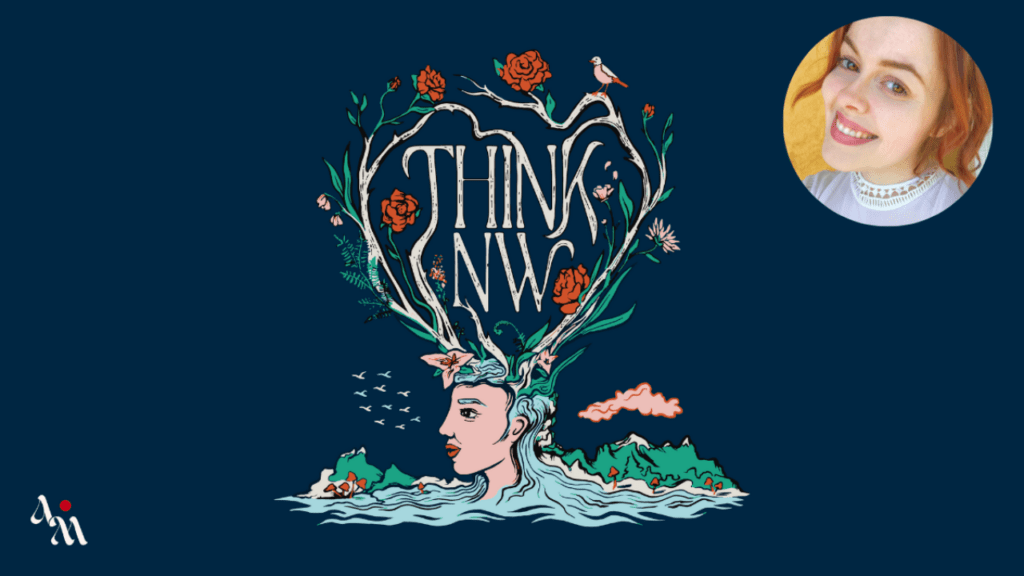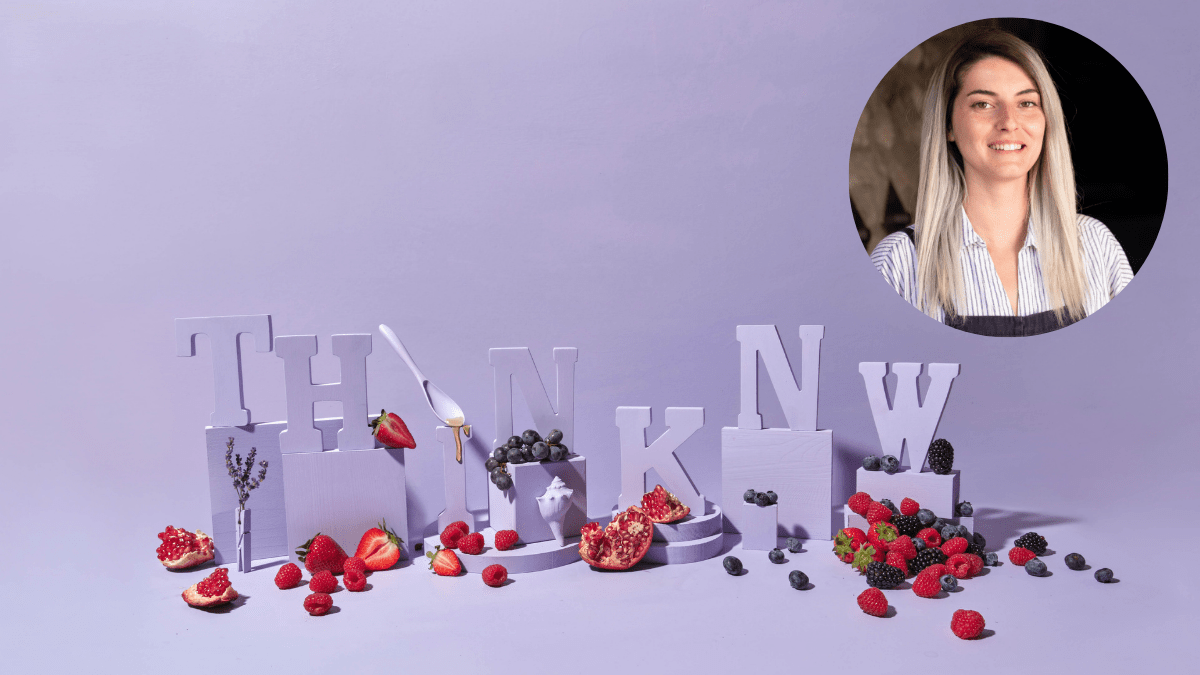June Logo Remix: Damascus Purnell

Every month, we invite a new artist to take the ThinkNW logo and make it their own. We asked artist Damascus Purnell, a Seattle-based Graphic Designer for the University of Washington Intercollegiate Athletics, for his take on the June logo.
How did you initially want to approach your interpretation of the ThinkNW logo? What were your thoughts and inspiration?
The first thing on my mind was interpreting what the Northwest meant to me and how it influenced my work. From there, visually, I wanted to challenge myself and do something somewhat new for myself. Inspiration really came from my current situation in life, living in the Northwest and how I saw myself existing here. Along with a ton of time thumbing through reference books.
How did you initially want to approach your interpretation of the ThinkNW logo? What were your thoughts and inspiration?
The first thing on my mind was interpreting what the Northwest meant to me and how it influenced my work. From there, visually, I wanted to challenge myself and do something somewhat new for myself. Inspiration really came from my current situation in life, living in the Northwest and how I saw myself existing here. Along with a ton of time thumbing through reference books.
How did the direction in designing the ThinkNW logo evolve/change over time?
I started with some sketches and flipping through some of my favorite books. Began with some illustration ideas, but I think seeing that so many previous LOGO REMIXs were illustrated, I wanted to do something different and landed on using photography and typography. From there, I probably went through 6-7 different variations of an idea similar to what I landed on. Often tweaking the location of the type & playing with the white space.
What are some of the specific elements in the ThinkNW logo design that you feel are unique/cool/fun (i.e., palette, illustration, overall style)?
I wanted to break up the typography and use it as a medium to move the eye through the piece. I made the “think” part lowercase and northwest Capitol to hit home on the images that made up the piece and their correlation to the northwest, more specifically, Seattle for me. I think it’s unique in the message along with the collage style as a design itself.
I used original photos I took in Seattle that often documented the changing landscape & population of the city. Like the man on the left, he was an unhoused person I met while shooting in pioneer square who opened a conversation with me by asking if these old weathered dilapidated boxes of cookies laying on the ground near me were mine. It was genuine coming from him, but I was almost taken aback, like it was beneath me to ever even imagine eating those. He had some questions about what my friend and I were doing. I don’t like using unhoused people as subjects in my photos often, but he asked for the photo, so I took it. That experience stuck with me in my work and life as well. I felt it was a microcosm of the situation in Seattle for the poor & more specifically, poor people of color.
A few examples of the images I chose were graffiti from the international district, a crane, a local artist recently incarcerated and signage from an elementary school that read “Black Lives Matter at Lowell Elementary”. That crane represented the high rises going up and the historical places of culture going down. The gentrification of the central district. A metaphor for the height of lifestyle I probably won’t attain.
The third important aspect I felt was unique was the old clippings from newspapers and other publications from Seattle’s past. Articles on strict redlining laws and newsletters about how specific areas were white only. It wasn’t until 1976 the city council did something about the blatant discrimination.
I think it’s convenient and easy for people, in general, to put some traumatic things in the rearview, but that was only some 40 years ago. Those laws and practices affected the black population here to this day. Houses often stay in families, with black people in Seattle not given that chance from the beginning and only a few options historically in the South End & Central district. But now, due to Seattle’s gentrification, they’re being pushed out again. While many people argue systemic racism doesn’t exist, not only was the US built on it, the cycle continues only less boldly and more silently through other mechanisms.
All those different forms of media tied together in a larger idea I wanted to present, “how can a person of color exist here”? How do I, as a POC, exist and not only survive but thrive here? Seattle is an incredible city. I was born in Seattle and raised in the Puget Sound area. Now in my 30s, it seems intangible to live here for most people in general and even more as someone in my demographic. It’s an issue of greed, income inequality, poverty and racism all in one. I wanted to use this design to shed some light on the past and how it’s affected things today. I love Seattle, and it’s great, but there needs to be more change enacted besides a BLM sign on your lawn.
When did you know that art was something that you wanted to pursue?
Honestly, as far back as I can remember, some early memories are of me being 4-5 yr old with my mom creating scrapbook collage-type dinner table mats from photos of my family and me. Along with other mediums like markers and stickers. I always took art classes and would be drawing anything I was a fan of, from Anime characters to NBA players. I got into graffiti during middle school and high school, so that took up a lot of my energy art-wise. That passion evolved over time and sort of manifested in an interest in the design field around my sophomore year of high school when I won a national logo design competition. A couple of years after high school, I got a camera and expanded my artistic mediums. With affirmations of my skills throughout college from other artists, features in publications and professors, I sort of knew what I wanted to do.
What are your biggest inspirations in your art (i.e., people, places, things)?
I think just being out and about: walks to work, rides on the light rail, bike rides, local live shows, old signage around town, graffiti and telephone pole posters stacked on each other. Seeing how other humans have decided to present visual information in the public space intrigues me. Music is huge for me. Other creatives and designers like Virgil Abloh, Basquiat, Mark Bradford, David Carson, Paula Scheer, and graffiti artists like Kase 2. Sometimes it’s not really about the visuals they’ve created but inspiration more broadly in creating and confidence in that act.
Do you think that you have a style? If so, how would you describe it? If not, why is that?
I guess I do, it’s consciously done and also organic. I try not to think in that term of a style because I feel like as soon as you do, people tend to box you in it. It’s like I have a rough idea and map planned. But then there are little offshoots from that path. I tend to appreciate the duality of typography and the specific curves dialed into perfection juxtaposed with chaotic clippings of other images.
What is most important to you when expressing your art?
Hard to put into words. But I’d say just doing it in a unique way and with purpose. For me personally, at least. I feel like when I’m working on something, there are these little parts in my work I feel I’ve seen before and feel comfortable in. But as a whole, I question it for days, weeks, months or longer. In most cases, I come back and feel great about it. But that kind of helps me feel like I’ve done something new. It was challenging me. I think the best art challenges you. I notice the best musicians often go through that with their fan base sometimes. Sometimes it takes a couple of listens or even years for people to catch on to something that sort of went over their heads because they were used to something else. But all the same, principles were there the whole time.
Where do you feel your art is going next?
Not sure, honestly, I think it will revolve around the medium being used to present it. Something with furniture or larger installation art would be a cool space to enter. Somewhere in between some of the new VR technology & our physical space would be fun to play with. Something interactive with the public or the people viewing my art in which it becomes a collaboration with them. I think that’d be fun.
Learn more about Damascus Purnell and his work:
damascuspurnelldesign.com / LinkedIn / Instagram




